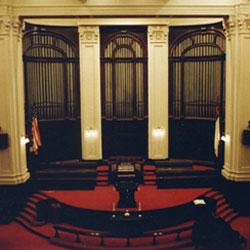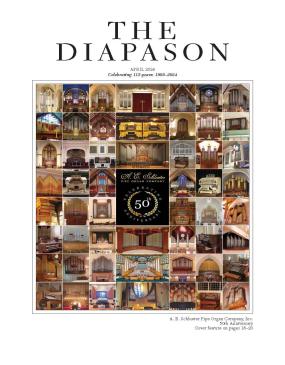
Grand Avenue Temple United Methodist Church, located at 205 East Ninth Street, in Kansas City, Missouri, will be hosting the 100th Birthday party for E. M. Skinner Opus 190 pipe organ on Sunday, 25 March at 3:30 p.m.
Dr. John Schwandt, Associate Professor of Organ and founding Director for the American Organ Institute at the University of Oklahoma, will be performing. His program is as follows.
Pieces with an * are from the original dedicatory program.
*1. Festival March - Edward Kreiser
*2. Andante from Symphonie Pathetique - Tchaikovsky
3. Toccata in G - Dubois
4. "The Swan" from Carnival of the Animals - Saint-Saens
*5. Elfentanz - Bernard Johnson
6. Sonata Op. 65, no. 1 - Felix Mendelssohn
*7. At Twilight - Frysinger
8. The Squirrel - Powell Weaver
9. Improvisation on submitted themes
A Grand Tribute for the Grand Old Organ on Grand
History has a way of repeating itself through events and culture. At a time when many churches have abandoned the pipe organ for musical support in the worship service, it is enjoying a nationwide resurgence of popularity in concert halls, as evidenced recently by two sold out inaugural recitals on the new organ in the Kauffman Center’s Helzberg Hall.
A century ago, Kansas City was celebrating a new pipe organ of innovative design built by Ernest M. Skinner of Boston for the newly completed Grand Avenue Temple at 9th and Grand Avenue. Skinner was the most sought-after builder at that time. On Sunday, 25 March, at 3:30 p.m., the 3,000 pipes of this oldest, most complicated, and still functioning machine original to Kansas City will be heard in a concert presented by Dr. John Schwandt, Professor of Organ, University of Oklahoma.
After working for several long-time East Coast organbuilders, at the turn of the 20th Century, Ernest M. Skinner opened his own shop in 1905. He introduced a new style of pipe organ, employing state-of-the-art electrically assisted mechanics, and newly developed pipe forms, to reproduce orchestral tone. At that time, the pipe organ was at home in church, temple, lodge and concert hall. It was the perfect choice of instrument for the new Grand Avenue Temple, a modern auditorium-style worship facility and public hall built in Classical revival architectural style.
The popular music of any time period rarely achieves the staying power of classical masterpieces from previous times. A similar problem confronts the pipe organ, which straddles the line between being a machine, and art.
Unlike other musical instruments, the use of standardized, mass-produced parts in the construction of an electric action pipe organ, allows frequent tonal modifications to an instrument after completion. As a result, the human proclivity to changing taste has created situations where religious organizations and concert hall owners with sufficient funds, can significantly modify, completely replace, wall off or do away with their pipe organs, all in the name of fashion.
Dr. John Schwandt’s 3:30 p.m. recital March 25th provides a rare opportunity to hear most of the original and largely forgotten works played at the dedicatory recital a century ago, brought back to life using the same innovative tonal colors that the congregation and concertgoers first heard one hundred years ago, when the pipe organ was as popular as present-day popular artists.
The Industrial Revolution of the late 19th century ushered in many changes in pipe organ design. By the 20th century, large electric fan turbines replaced human laborers, who hand-pumped the organ’s bellows in the previous century. Electric circuits replaced the mechanical connection between the keys and the valves, admitting air to the pipes.
Because of these, and other technological advances, pipe organs increased in size, versatility and power. No amount of hand-pumping could generate enough wind for the Skinner’s pew-rattling 32 foot long pedal pipes, which are large enough for any teenager to crawl through. Electro-pneumatic action allowed the organist to make sudden tonal changes, and quick change of dynamic levels by the use of expression shutters that look like a venetian blind, for additional dramatic effect.
As Skinner’s style was copied by other organbuilders, the transcription of familiar orchestral works for the pipe organ became popular concert repertoire for audiences in smaller municipalities where a professional orchestra was prohibitively expensive. By the 1920’s, the theatre pipe organ represented another means of reproducing popular music for silent movies.
After World War II, a new generation of organists began advocating for the authentic performance of works by Johann Sebastian Bach and others before 1800. American organbuilders, some exposed to antique European organs during their military service, began building mechanical action organs. In recent years, the pendulum has swung back to Romantic works of the 19th Century. Concert organists are also rediscovering transcriptions and the art of improvisation which made the instrument so accessible to audiences in the first 35 years of the 20th Century.
Grand Avenue Temple was built as a mega-church of its day, when urban congregations vied for prominent locations on main thoroughfares near public transportation. The congregation staked the site in 1865, and instead of leaving for the suburbs as the urban core developed around it, elected to construct a small skyscraper attached to its new auditorium style worship space, as a way to generate income and pay off the mortgage.
This plan fell apart during the Great Depression, and the congregation’s limited financial situation, coupled with an abiding appreciation for the Skinner organ’s tonal qualities, spared it from modification or destruction. The only tonal changes were made by Skinner, who returned to inspect the organ in 1949 at the age of 83.
As the congregation’s mission has shifted toward street ministry over the last 50 years, the organ has been saved through a series of curates, including longtime organist, Kenneth Fletcher, who appreciated the organ’s rich orchestral sonorities, and organbuilder, Michael Quimby, of Warrensburg, Missouri, who recognized the organ’s historical merit.
Over the last 40 years, Quimby has contributed much of his time and expertise to help the congregation maintain the pipe organ's integrity, and keep the organ playing as age, nearby fires and occasional catastrophic roof leaks have threatened its survival. The 100th birthday celebration is due to the enthusiastic support of church’s pastor, Rev. Ron Brooks, Steve Greene, Minister of Music, and the Organ Committee.
Because it is the earliest and largest unaltered example of Ernest M. Skinner’s work, this pipe organ was one of the first 20th century electro-pneumatic pipe organs in the United States to be recognized with a Historic Organ Citation from the Organ Historical Society, headquartered in Richmond, Virginia.

